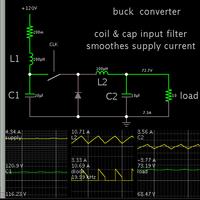Follow along with the video below to see how to install our site as a web app on your home screen.
Note: This feature may not be available in some browsers.

If your MPPT point is 120v, as it would be with four 24v panels in series, or eight 12v panels in series, you only need to reduce the voltage, so Brad's suggestion of a buck topology will be the simplest and easiest to implement.I want to drive a PMDC motr. I only want to drive in one direction only.
motor specifications 2HP 120v 14A
Input 120V DC
what topology should i choose?
The MPPT point is only true for the "nominal" ammount of sunlight.
It will change with the ammount of sunlight.
The MPPT point is only true for the "nominal" ammount of sunlight.
It will change with the ammount of sunlight.
P = power...This is not so.
But if we are using chopper, motor will be working on voltage less than 120v. so motor can't deliver full output right?
We both posted simultaneously.Okey i am kind of getting the idea of MPP
so current is the problem right?
If i draw more current from the panel at a particular irradiance ie above Imp the panel voltage drops drastically. Right?
so our idea is to limit the current below the Imp. That is why we are adjusting the duty cycle of chopper.
so basically we controlling the voltage to the motor so current also controlled.
right?
One doubt is that motor voltage and current has a linear relationship or not?